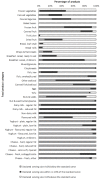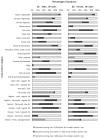Large Variations in Declared Serving Sizes of Packaged Foods in Australia: A Need for Serving Size Standardisation?
- PMID: 29382083
- PMCID: PMC5852715
- DOI: 10.3390/nu10020139
Large Variations in Declared Serving Sizes of Packaged Foods in Australia: A Need for Serving Size Standardisation?
Abstract
Declared serving sizes on food packaging are unregulated in Australia, and variations in serving size within similar products reduces the usability of this information. This study aimed to (i) assess the variations in declared serving sizes of packaged foods from the Five Food Groups, and (ii) compare declared serving sizes to the Australian Dietary Guidelines standard serves and typical portion sizes consumed by Australian adults. Product information, including serving size, was collected for 4046 products from four major Australian retailers. Within product categories from the Five Food Groups, coefficients of variation ranged from 0% to 59% for declared serving size and 9% to 64% for energy per serving. Overall, 24% of all products displayed serving sizes similar (within ±10%) to the standard serves, and 23-28% were similar to typical portion sizes consumed by adults, for females and males, respectively. In conclusion, there is substantial variation in the declared serving sizes of packaged foods from the Five Food Groups, and serving sizes are not aligned with either the Dietary Guidelines or typical portion sizes consumed. Future research into effective means of standardising serving sizes is warranted.
Keywords: dietary guidelines; food labelling; food legislation; portion size; serving size.
Conflict of interest statement
The authors declare no conflict of interest.
Figures


Similar articles
-
Consumer Understanding, Perception and Interpretation of Serving Size Information on Food Labels: A Scoping Review.Nutrients. 2019 Sep 11;11(9):2189. doi: 10.3390/nu11092189. Nutrients. 2019. PMID: 31514395 Free PMC article.
-
High variation in manufacturer-declared serving size of packaged discretionary foods in Australia.Br J Nutr. 2016 May 28;115(10):1810-8. doi: 10.1017/S0007114516000799. Epub 2016 Mar 17. Br J Nutr. 2016. PMID: 26983935
-
Variations in serving sizes of Australian snack foods and confectionery.Appetite. 2016 Jan 1;96:32-37. doi: 10.1016/j.appet.2015.08.042. Epub 2015 Sep 4. Appetite. 2016. PMID: 26344813
-
The effects of increased serving sizes on consumption.Appetite. 2016 Jun 1;101:71-9. doi: 10.1016/j.appet.2016.02.156. Epub 2016 Feb 27. Appetite. 2016. PMID: 26928789
-
Serving Size and Nutrition Labelling: Implications for Nutrition Information and Nutrition Claims on Packaged Foods.Nutrients. 2018 Jul 12;10(7):891. doi: 10.3390/nu10070891. Nutrients. 2018. PMID: 30002339 Free PMC article. Review.
Cited by
-
Portion Size Norms of Discretionary Foods and Eating Settings: A Repeated Cross-Sectional Study.Nutrients. 2024 Oct 28;16(21):3670. doi: 10.3390/nu16213670. Nutrients. 2024. PMID: 39519502 Free PMC article.
-
Nutritional information on the labels of processed and ultra-processed foods and beverages marketed in a supermarket chain in Lima in 2022.Rev Peru Med Exp Salud Publica. 2023 Apr-Jun;40(2):141-149. doi: 10.17843/rpmesp.2023.402.12714. Rev Peru Med Exp Salud Publica. 2023. PMID: 38232260 Free PMC article.
-
Comprehensive Nutrition Review of Grain-Based Muesli Bars in Australia: An Audit of Supermarket Products.Foods. 2019 Aug 28;8(9):370. doi: 10.3390/foods8090370. Foods. 2019. PMID: 31466287 Free PMC article.
-
Consumer Understanding, Perception and Interpretation of Serving Size Information on Food Labels: A Scoping Review.Nutrients. 2019 Sep 11;11(9):2189. doi: 10.3390/nu11092189. Nutrients. 2019. PMID: 31514395 Free PMC article.
-
The Nutritional Quality of Food Donated to a Western Australian Food Bank.Nutrients. 2024 Feb 11;16(4):509. doi: 10.3390/nu16040509. Nutrients. 2024. PMID: 38398833 Free PMC article.
References
-
- Federal Registrar of Legislation Australia New Zealand Food Standards Code—Standard 1.2.8—Nutrition Information Requirements. [(accessed on 10 August 2017)]; Available online: https://www.legislation.gov.au/Details/F2017C00311.
-
- Food Standards Australia New Zealand Nutrition Information Panels. [(accessed on 10 August 2017)]; Available online: http://www.foodstandards.gov.au/consumer/labelling/panels/Pages/default.....
MeSH terms
LinkOut - more resources
Full Text Sources
Other Literature Sources

